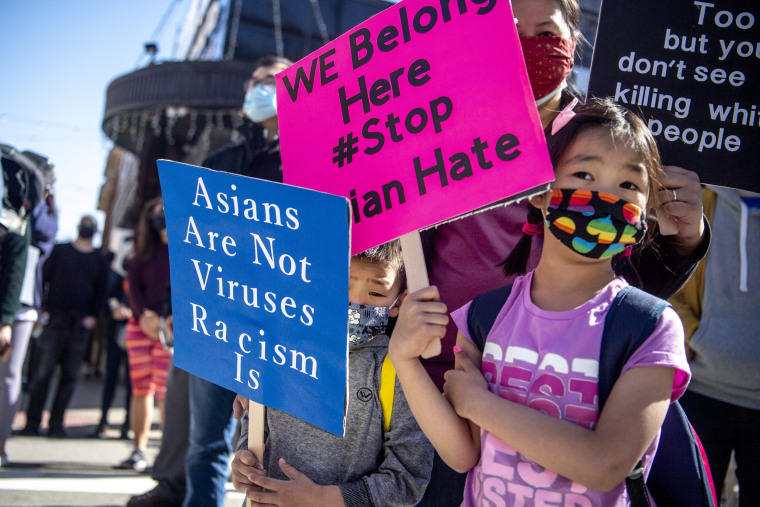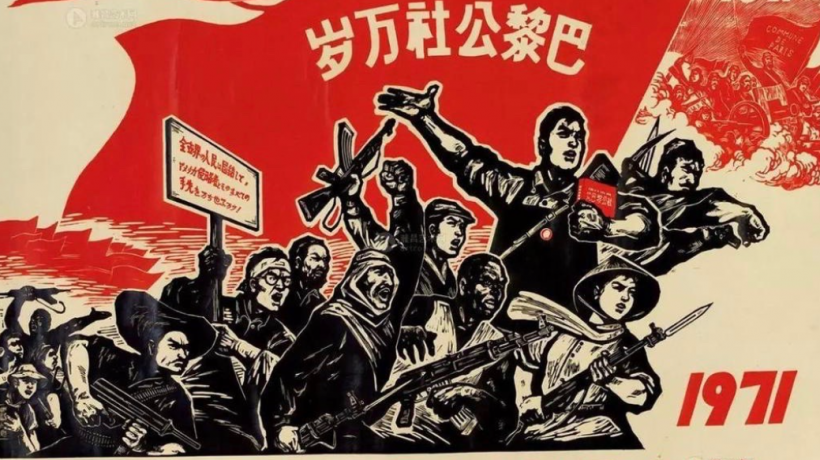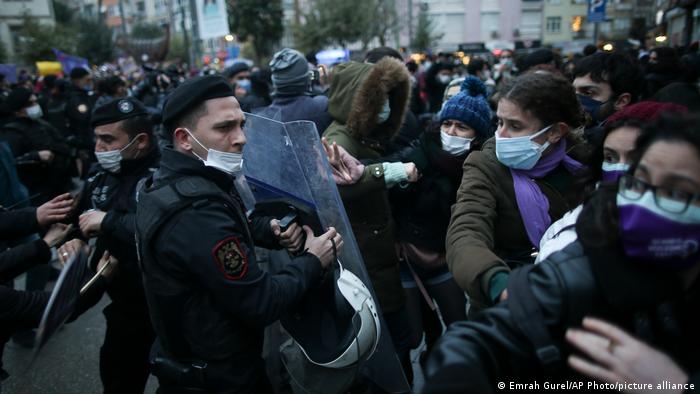Guangzhou 1927: The Paris Commune of the East
On the 150th anniversary of the beginning of the Paris Commune, its legacy is remembered in the Guangzhou Uprising, when workers and peasants established a popular republic in the southern Chinese capital in 1927.(Mar-Apr 2021)
It was in the Russian autumn of 1920 when Qu Qiubai first heard L’Internationale – the socialist anthem born of the Paris Commune of 1871. Eugène Pottier, author of the song’s lyrics, was a Communard and elected member of the workers’ state that lasted 72 days in the French capital. Though written nearly half a century earlier, that song had been adopted only recently as the anthem of the Bolshevik Party. Until today, this song is one of the most translated and sung anthems of the oppressed around the world. Qu was attending the third anniversary celebration of the October Revolution, having traveled through Harbin – China’s northernmost provincial capital – to reach Russia. Fluent in French and Russian, he was sent to be a correspondent in Moscow for the Beijing Morning News (晨报), covering the early years of the Bolshevik Revolution.
In 1920, the communist movement in China had barely begun, but the nation was hungry for its ideas. The colonial plunders of two Opium Wars marked the beginning of the “century of humiliation”, which saw the ceding of Hong Kong to the British and the sacking of the Old Summer Palace by Anglo-French forces. The Qing dynasty fell in 1911 only to be succeeded by a puppet Republican government. The country was divided, feudalism and warlordism were rampant. The Chinese people were hungry – physically and spiritually – for its nation to be set free.
Like the thousands of young radicals of the time, Qu was politicized in the May Fourth Movement of 1919. The Paris Peace Conference at the end of World War I saw the ultimate betrayal of China’s interests – instead of having its territories returned, the Western Allies would agree to transfer Shandong Province from the colonial hands of Japan to Germany. In response, a national movement led by students in Beijing was born, anchored in anti-imperialist, anti-feudal and anti-patriarchal politics. This awakening gave birth to the New Culture Movement – with New Youth as its key publication – and an opening for new ideas to guide the country’s transformation. Among its leaders were Beijing University professors, Chen Duxiu and Li Dazhao, who were pivotal in bringing Marxist ideas into China. They both helped found the Communist Party of China (CPC) in 1921.
The betrayal by Western Allies was felt all the more after the contributions that the Chinese people made to the Great War. To meet their growing labor shortages, French and British states relied heavily on the colonies across Africa, Indochina and China. 140,000 Chinese people – mostly peasants – joined the French and British war efforts, while another 200,000 fought on the Eastern Front with the Russian Red Army. The Chinese Labor Corps did every task but bear arms – they dug trenches, worked in munition factories, repaired equipment on the frontlines, buried the dead. Thousands died, though this part of history is little told in the West. Around that same time, there was another group of young Chinese people heading to France. Originally initiated by Chinese anarchists in 1908, the program became formalized into the Diligent Work-Frugal Study program in 1919 that brought 2000 Chinese workers and peasants to Paris – they would work in factories in return for their Western education. The poor living and working conditions politicized many of these students – on February 28, 1921, 400 Chinese work-study students demonstrated against further reductions in bursaries. Events like this one brought the movement closer to the WWI-generation workers as they began organizing together in the Renault factories from the industrial suburbs of Boulogne-Billancourt to La Garenne-Colombes. It was from the factory floors and in the university halls where Marxism would enter the Chinese revolutionary thought. Among the students were Zhou Enlai and Deng Xiaoping, founders of the European branch of the CPC. Zhou Enlai would serve as Premier for 26 years and Deng Xiaoping, the Chinese leader who succeeded Mao Zedong upon the founding of the People’s Republic of China (PRC).
BRIGHT FLOWER, HAPPY FRUIT
Though the Paris Commune was largely unknown to the Chinese public up until that point, these exchanges among workers and intellectuals in France, and the ideological opening that the May Fourth Movement created, helped bring that history forward. Several early communist leaders studied, wrote and popularized the history of the workers’ state. In 1920, Li Da – one of the 12 founding members of the CPC – wrote about the need for the Chinese Revolution to take the path of armed struggle. In 1922, Zhou Enlai wrote in New Youth (新靑年) about the “short-lived flower” of the Paris Commune and its continuation in the October Revolution. The following year, in the 50th anniversary edition of Shen Bao (申報)– one of China’s first modern newspapers – Li Dazhao first explained the concept of the “commune” to a Chinese public. First transliterated as kangmiaoen (康妙恩), the revolutionary concept gained its own form in the Chinese language, gongshe (公社) – a workers’ republic.
Qu Qiubai was among the communists who not only translated essential texts on the Commune’s history but was also the first to translate L’Internationale into Chinese – the song he first heard in Russia three years before. While playing the organ, he painstakingly revised the lyrics to find a translation of the word “international” – which only has two syllables in Chinese (国际) – that could suit the melody. He finally settled on the transliterated ying te na xiong nai er (英特纳雄耐尔) to keep true to the cadence of the song, which remains in the officially adopted version until today.
By this time, Qu had already joined the CPC, upon the invitation of Zhang Tailei in 1922. A year earlier, Qu also met the Bolshevik leader Lenin, who had studied intimately the lessons of the Paris Commune. Just months before leading his own country to revolution, Lenin dedicates a chapter on it in The State and Revolution (1917):
The Commune is the first attempt by a proletarian revolution to smash the bourgeois state machine; and it is the political form “at last discovered”, by which the smashed state machine can and must be replaced.
We shall see further on that the Russian revolutions of 1905 and 1917, in different circumstances and under different conditions, continue the work of the Commune and confirm Marx’s brilliant historical analysis.
In some short months after its publication, the October Revolution would indeed continue the work of the Commune and confirm Marx’s analysis. In this tradition, the Chinese communists would also carry on these the legacy of these two revolutionary experiences.
On 18 March 1926, the first mass commemoration of the 55th anniversary of the Paris Commune took place in China. 10,000 people gathered in the southern capital of Guangzhou. They sung L’Internationale and chanted “Vive la Commune de Paris!” despite the rain. On this occasion Mao Zedong writes, if the Paris Commune was a “bright flower”, then the October Revolution was the “happy fruit”, from which more fruits could be born. On the Commune’s ultimate defeat, Mao points to two reasons: the lack of a unified and centralized party to lead the workers, and the compromise of showing too much mercy to the enemy. In his keynote speech at the celebration, the Cantonese leader, Zhang Tailei, pointed to the concrete experience that the Paris Commune gave for Chinese workers to take power – a foreshadowing of what would come in the following year.

Paris Commune 100 year stamps.
FROM THE CITY TO THE COUNTRYSIDE
The 1920s saw a rapid expansion of the urban working class – trade unions multiplied, strikes were frequent and the CPC’s ranks grew with the organization of the masses. In the industrial center of Shanghai alone, 1926 saw 169 strikes affecting 165 factories involving over 200,000 workers. In Guangdong, the Seamen’s Strike of 1922 was victorious and the Guangzhou-Hong Kong General Strike of 1925 lasted 16 months and garnered unprecedented mass support from domestic workers, dockworkers, rickshaw drivers and “coolies”. These experiences showed how organized labor could threaten colonial life and capitalist order.
Despite industrialization, China was still an overwhelmingly peasant society. In his 1926 Analysis of Classes in Chinese Society, Mao studied the composition of China’s 450 million population. The urban proletariat, however quickly it was growing, still only totaled two million people – the vast majority of Chinese people were peasants. Mao estimated 400 million people were “semi-proletariat” who farmed their own land, but also earned wages as tenant farmers or wage laborers – he called them “our closest friends” (Analysis of the Classes in Chinese Society, 1926).
In this foreboding text, Mao also warned that the national bourgeoisie forces could not be trusted. At that historical moment, the CPC was in an alliance with the national bourgeoisie led by the Nationalist Party (KMT) in a “United Front” against warlordism and imperialism. That pivotal year would see an abrupt end to this alliance and the subsequent “White Terror” of mass killings of communists at the hands of the nationalists and their hired hands. The mass insurrections of 1927 were attempts at transforming the symbol of the Paris Commune into a living practice in China, and necessitated a strategic shift in the revolutionary process.
The 1927 commemoration of the Paris Commune ballooned in size, drawing up to one million workers and peasants across the country. At the Wuhan celebration, labor leader Liu Shaoqi called on the workers to carry on the spirit of the Paris Commune jointly with the struggle against imperialism and warlordism. Three days later, 800,000 workers led by Zhou Enlai launched a general strike in Shanghai that overthrew the warlord-controlled government and established a Provisional Municipal Government. Shanghai became the first large city under the leadership of the CPC. But on 12 April, defying the United Front strategy, the KMT under Chiang Kaishek would stage a coup and order the slaughter and disappearance of thousands of Communists with the aid of police of the foreign-occupied areas and criminal organizations. The CPC-KMT alliance was over. The subsequent communist-led urban uprisings from Nanchang (1 August) to Hunan (7 September), and finally to Guangzhou (11 December), would all be brutally crushed.
ALL POWER TO THE WORKERS’, PEASANTS’ AND SOLDIERS’ SOVIETS!
At 3:30 am on 11 December, the first attack began at the police stations. It was led by commander Zhang Tailei, who was killed in an ambush the following day – he was 29 years-old. A series of coordinated actions took over the city. Their demands were: Rice for the workers, land for the peasants! Down with militarist wars! All power to the Workers’, Peasants’ and Soldiers’ Soviets! Behind this mobilization was the Guangzhou Soviet, covering an area of half a million peasants working in conjunction with the urban workers unions. A war council with a 10:3:3 ratio of workers, soldiers and peasants, respectively, led the uprising that lasted three days. Upon taking the city, this body issued a series of eight decrees, mass printed and distributed. The first three focused on the establishment of Soviet power, arming of the people and retaliation against counter-revolutionaries. The fourth secured an eight-hour working day and rights for the waged and unemployed. The fifth dealt with the economy and the nationalization of industry. The sixth demand looked at the property of the bourgeoisie. The seventh to the army wages and restructuring. The eighth and final demanded the reorganization of trade unions. At that moment, however, the military organization of the bourgeoisie was still too strong. Had they held the city long enough for the peasant reinforcements – a six-day march away – history may have turned out differently. Ralph Fox – British journalist and communist later killed fighting in the Spanish Civil War – wrote on the significance of the “Guangzhou Commune”:
For three days a great city in an eastern country dominated by imperialism was seized and held by the oppressed classes ruling through their Soviet. Technical and military errors there were, but, politically, no mistakes were made. The Communist Party of China, which led and organized the revolt, has reason to be proud of its application of Lenin’s teachings in the difficult circumstances of China. The work of the Party in the insurrection showed not only that it had the closest contacts with workers, peasants, petty bourgeoisie and soldiers, but that it understood how to rally the widest masses of all these classes to the support of the revolution by correct slogans and a sure political line. (The Commune of Canton, 1928)
1927 was a turning point for the Chinese Revolution. That the uprisings were brutally repressed was pivotal in the CPC’s strategic shift from the cities to the countryside – towards the creation of a people’s army and towards the peasantry – “our closest friends”. In Lessons of the Commune (1908), Lenin writes, “And although these magnificent uprisings of the working class were crushed, there will be another uprising, in face of which the forces of the enemies of the proletariat will prove ineffective, and from which the socialist proletariat will emerge completely victorious.” Something similar could be said of the Chinese uprisings. After that year of White Terror, at the Sixth Congress of the CPC in 1928, 11 December was officially marked as the anniversary of the Guangzhou Uprising, which “not only opened a new chapter for the Chinese Revolution but also has great significance in the history of world revolution, with the same value as the great Paris Commune”. Holding true to this, the Guangzhou Commune has indeed been remembered, studied and honored since.
2020 was the 93rd anniversary of the Guangzhou Uprising, which became known as the “Paris Commune of the East”. For this occasion a new “red drama” was produced in conjunction with an exhibition at the Guangzhou Uprising Memorial Hall. The late-Qing dynasty building was once used as a Police Academy before being transformed into the seat of the Guangzhou Soviet. In 1987, this site was turned into an official memorial. At the 12 December commemoration event, students from the People’s Liberation Army school recited the tale of Zhang Tailei, a puppet show told the story of the Uprising’s female leaders and the great granddaughter of hero Yang Yin tied a red ribbon around a student’s collar – the symbolic passing on of a revolutionary legacy from one generation to the next.
Up until the anniversary, the immersive drama was performed four times a week. Actors and audience members alike jointly reenact the uprising, donning costumes and taking up weapon props, all the while singing L’Internationale. When Qu Qiubai first heard this song in Russia a century ago, he probably had little idea what role he would play in bringing this anthem from the “bright flower” of the Paris Commune to the Guangzhou Commune. He never lived to see the “happy fruit” in the establishment of PRC in 1949, nor the centenary of the founding of the CPC on 1 July of this year. In 1935, he was captured, tortured and executed by KMT forces. It is said that he sang L’Internationale until his last breath.
Courtesy: Peoples Dispatch
Tings Chak is the lead designer and researcher of Tricontinental: Institute for Social Research, editor of Dongsheng News and a Globetrotter/People’s Dispatch fellow.
THIS IS A PRELUDE ARTICLE TO POSTINGS ON THE 150 ANNIVERSARY OF THE PARIS COMMUNE 1871-2021 WHICH WILL CONTINUE HERE SUNDAY MARCH 21.
















